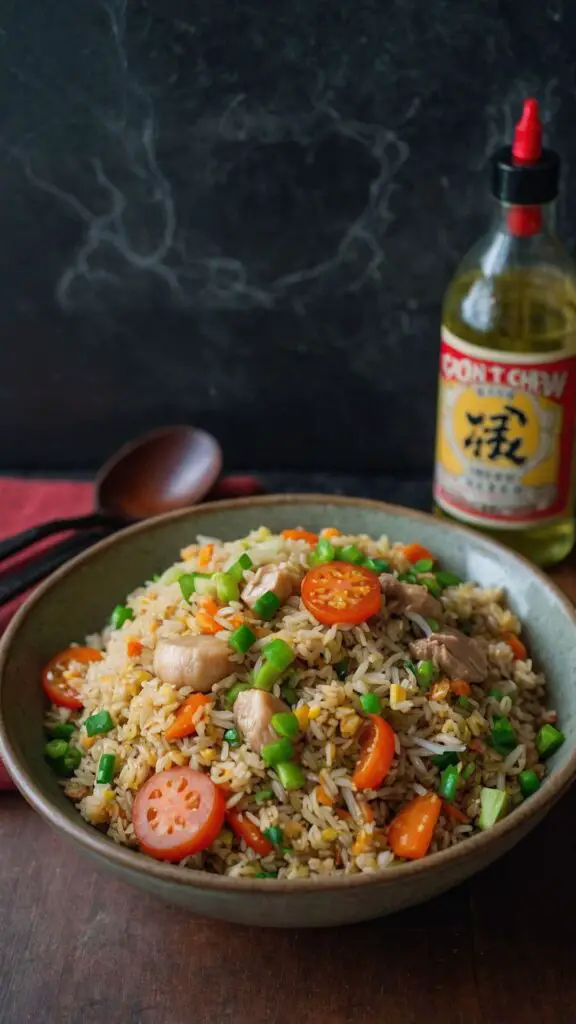Young Chow Fried Rice Recipe – Culinary Chase
I have an appetite for great flavors and culinary stories. Whenever I think about a reliable centerpiece for a meal, Young Chow fried rice always springs to mind. Perfectly seasoned and packed with a variety of textures, this dish can elevate any occasion.
But let’s be honest: you can’t just whip up fried rice on a whim without thinking about the right complementary dishes.
Pairing Young Chow fried rice with something light, like simple stir-fried veggies or sweet and sour chicken, makes for a well-rounded meal. However, it’s the fried rice that often steals the show.

What is Young Chow Fried Rice?
Young Chow fried rice, also known as Yang Chow fried rice, originated from southern China, specifically the Yangtze River Delta region. It’s not just any fried rice; it combines various ingredients like shrimp, ham, and roast pork with perfectly cooked rice, resulting in a delicious medley.
The cooking techniques might sound simple, but the balance of flavors in Young Chow fried rice is simply fantastic. In my experience, it’s a dish that showcases the essence of Chinese cooking: a harmony of taste, texture, and technique.
You will also like the following Lunch and Dinner recipes!
The Ingredients
Before diving into the cooking process, let’s gather our ingredients. This is where the magic begins.
- 2 large eggs, lightly beaten
- 3 tablespoons vegetable oil
- 1 teaspoon minced garlic
- 4 ounces fresh peeled shrimp
- 1 medium yellow onion, finely chopped
- 1/2 cup diced Virginia ham
- 1/2 cup diced Chinese-style roast pork
- 5 cups steamed rice
- 3/4 cup thawed green peas
- 1 teaspoon toasted sesame oil
- 1 1/2 teaspoons kosher salt
- 1/4 teaspoon granulated sugar
- 1 teaspoon Shaoxing cooking wine
- 2 scallions, thinly sliced
- 2 cups shredded romaine or iceberg lettuce
- 1/8 teaspoon freshly cracked white pepper

How to Make Young Chow Fried Rice?
Creating Young Chow fried rice is straightforward and satisfying. However, like any great recipe, it requires some attention to detail and timing. Let’s break it down step by step.
Step 1: Prepare Your Ingredients
Start by making sure everything is prepped and ready to go. Dice the ham and roast pork, chop the onion, and measure out your peas. Having everything at your fingertips makes the cooking process smoother.
Trust me; you don’t want to scramble around looking for ingredients while the oil is getting hot!
Step 2: Heat the Oil and Cook the Eggs
In a large skillet or a wok, heat the vegetable oil over medium-high heat. Add the beaten eggs and scramble them until just set.
This should only take about a minute or so. Once they’re cooked, transfer the eggs to a plate and set them aside.
Step 3: Sauté the Aromatics
In the same skillet, add a bit more oil if needed and toss in the minced garlic. Stir for about 30 seconds until it gets fragrant (but beware of burning!). Then, throw in the chopped onion and sauté until it turns translucent.
Step 4: Add Proteins
Next, add the shrimp, diced ham, and roast pork to the skillet. Sauté them for 3 to 4 minutes until the shrimp turns pink and everything heats through. This step adds layers of flavor thanks to the varying tastes of the meats.
Step 5: Incorporate the Rice
Now comes the fun part! Add the steamed rice to the pan. Make sure to break up any clumps as you stir. It’s important that your rice is day-old; it helps achieve that perfect fried texture without being mushy.
Step 6: Season the Dish
Once the rice is well mixed with the meat and veggies, it’s time to season. Add in the soy sauce, toasted sesame oil, salt, sugar, Shaoxing wine, and white pepper. Stir for a couple of minutes until everything is evenly coated in the sauce.
Step 7: Add the Finishing Touches
Finally, toss in the peas, scrambled eggs, and scallions. Stir everything to combine, ensuring that the peas heat through and the flavors meld together.
Don’t forget to add the shredded lettuce right at the end; its freshness balances the entire dish. Give it a final stir and voilà—you’ve made Young Chow fried rice!
Notes
Here are a few helpful tips I’ve learned over the years:
- Use Day-Old Rice: Freshly cooked rice tends to be too sticky and won’t fry as well. Day-old rice dries out a bit, which is perfect for frying.
- High Heat for Crispiness: Using a hot skillet or wok helps to achieve a nice crisp to the rice.
- Don’t Overcrowd the Pan: If you’re making a large batch, consider cooking in smaller portions. Too much in the pan can lead to steaming rather than frying.
- Customize to Your Taste: Feel free to add your favorite proteins or veggies. Everything from chicken to tofu can work well.
- Garnish for Extra Flavor: A sprinkle of sesame seeds or additional scallions on top provides a lovely finish.
Storage Tips
If you have leftovers, they can be stored in an airtight container in the refrigerator for up to 3 days. To reheat, a quick time in the microwave works, but I always recommend a stir-fry in the skillet for the best results. This helps revive that fried texture.
Nutrition Information
Young Chow Fried Rice Recipe Nutrition Facts
Serving Suggestions
Here are some ideas to make your meal truly spectacular:
- Stir-Fried Veggies: Incorporating seasonal vegetables, lightly sautéed with soy sauce, makes a great side dish.
- Sweet and Sour Chicken: The tanginess from the chicken complements the rice well.
- Spring Rolls: These crispy bites offer a delightful crunch and are a classic pairing.
- Hot and Sour Soup: The heat and tang of soup offers refreshment against the rice’s richness.
- Steamed Dumplings: Soft and filled with flavors, they serve as a fantastic companion to the fried rice.

What Other Substitutes Can I Use in Young Chow Fried Rice?
If you want to mix it up or don’t have certain ingredients on hand, consider these great substitutes:
- Chicken: Diced chicken breast can easily replace the shrimp or any other protein you prefer.
- Tofu: For a vegetarian option, tofu will soak up the flavors wonderfully and add protein.
- Quinoa: This is a great gluten-free alternative to rice. Cook it as per the package instructions before adding it to your stir-fry.
- Cauliflower Rice: A low-carb alternative, it offers a similar texture and pairs beautifully with the other ingredients.
- Zucchini Noodles: Spiralized zucchini can be a fun and nutritious substitute, providing an entirely different texture.

Young Chow Fried Rice Recipe
Equipment
- Skillet
Ingredients
- 2 large eggs lightly beaten
- 3 tablespoons vegetable oil
- 1 teaspoon minced garlic
- 4 ounces fresh peeled shrimp
- 1 medium yellow onion finely chopped
- 1/2 cup diced Virginia ham
- 1/2 cup diced Chinese-style roast pork
- 5 cups steamed rice
- 3/4 cup thawed green peas
- 1 teaspoon toasted sesame oil
- 1 1/2 teaspoons kosher salt
- 1/4 teaspoon granulated sugar
- 1 teaspoon Shaoxing cooking wine
- 2 scallions thinly sliced
- 2 cups shredded romaine or iceberg lettuce
- 1/8 teaspoon freshly cracked white pepper
Instructions
Step 1: Prepare Your Ingredients
- Start by making sure everything is prepped and ready to go. Dice the ham and roast pork, chop the onion, and measure out your peas. Having everything at your fingertips makes the cooking process smoother.
- Trust me; you don’t want to scramble around looking for ingredients while the oil is getting hot!
Step 2: Heat the Oil and Cook the Eggs
- In a large skillet or a wok, heat the vegetable oil over medium-high heat. Add the beaten eggs and scramble them until just set.
- This should only take about a minute or so. Once they’re cooked, transfer the eggs to a plate and set them aside.
Step 3: Sauté the Aromatics
- In the same skillet, add a bit more oil if needed and toss in the minced garlic. Stir for about 30 seconds until it gets fragrant (but beware of burning!). Then, throw in the chopped onion and sauté until it turns translucent.
Step 4: Add Proteins
- Next, add the shrimp, diced ham, and roast pork to the skillet. Sauté them for 3 to 4 minutes until the shrimp turns pink and everything heats through. This step adds layers of flavor thanks to the varying tastes of the meats.
Step 5: Incorporate the Rice
- Now comes the fun part! Add the steamed rice to the pan. Make sure to break up any clumps as you stir. It’s important that your rice is day-old; it helps achieve that perfect fried texture without being mushy.
Step 6: Season the Dish
- Once the rice is well mixed with the meat and veggies, it’s time to season. Add in the soy sauce, toasted sesame oil, salt, sugar, Shaoxing wine, and white pepper. Stir for a couple of minutes until everything is evenly coated in the sauce.
Step 7: Add the Finishing Touches
- Finally, toss in the peas, scrambled eggs, and scallions. Stir everything to combine, ensuring that the peas heat through and the flavors meld together.
- Don’t forget to add the shredded lettuce right at the end; its freshness balances the entire dish. Give it a final stir and voilà—you’ve made Young Chow fried rice!
Notes
- Use Day-Old Rice: Freshly cooked rice tends to be too sticky and won’t fry as well. Day-old rice dries out a bit, which is perfect for frying.
- High Heat for Crispiness: Using a hot skillet or wok helps to achieve a nice crisp to the rice.
- Don’t Overcrowd the Pan: If you’re making a large batch, consider cooking in smaller portions. Too much in the pan can lead to steaming rather than frying.
- Customize to Your Taste: Feel free to add your favorite proteins or veggies. Everything from chicken to tofu can work well.
- Garnish for Extra Flavor: A sprinkle of sesame seeds or additional scallions on top provides a lovely finish.
Nutrition
Frequently Asked Questions
Can I use frozen shrimp?
Absolutely! Just be sure to thaw them properly before cooking to ensure they cook evenly. Absolutely!
What’s the best rice to use?
Long-grain rice tends to work best due to its firmer texture, but jasmine or basmati can also provide wonderful flavors.
How do I prevent soggy fried rice?
The key is to use dry, day-old rice. If cooked rice is still moist, spread it out on a baking sheet to cool and dry before frying.
Can I make this dish vegetarian?
Yes! Just skip the meats and add extra vegetables along with tofu for protein.
Is Young Chow fried rice spicy?
It typically isn’t spicy, but you can add chili oil or red pepper flakes if you prefer a kick.
Conclusion
Making Young Chow fried rice offers more than just a meal; it creates an experience in your kitchen. Each step invites you into a flavorful journey, culminating in a dish that pleases any palate.
With its adaptability and delightful taste, it’s a recipe sure to impress family and friends. Whether you’re a seasoned chef or a beginner, I guarantee this dish will become a favorite in your culinary repertoire. Bon appétit!
